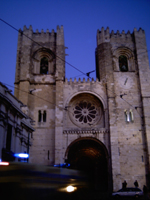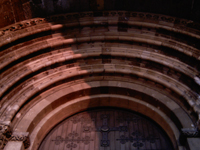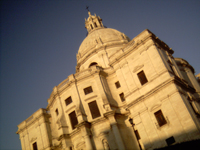 The church of Santa Maria Maior (Lisbon cathedral) was built
shortly after the reconquest of Lisbon from the Moors in 1147.
Many years later, having being significantly modified after
the 1755 earthquake and restoration at the beginning of the
19th and 20th centuries the church remains on the site on which
it was erected. As was customary at the time, the Church of
Santa Maria Maior was erected on the site of a large Moorish
mosque.
The church of Santa Maria Maior (Lisbon cathedral) was built
shortly after the reconquest of Lisbon from the Moors in 1147.
Many years later, having being significantly modified after
the 1755 earthquake and restoration at the beginning of the
19th and 20th centuries the church remains on the site on which
it was erected. As was customary at the time, the Church of
Santa Maria Maior was erected on the site of a large Moorish
mosque.
The Romanesque style of the Cathedral was, apparently, based upon the Sé Velha in Coimbra. The western façade sports an impressive rose window above the arched main door which is sandwiched between two crenellated and buttressed lateral towers.
Construction of the robust Se Catedral began in the 12th Century under the supervision of the master builder Mestre Roberto. The Se Catedral is comprised of two aisles either side of a central nave with two apses flanking a single sober chancel. The primary source of light is through slit-windows and and the arched triforium which runs the length of the vessel.
The first bishop of the Cathedral was one Gilbert of Hastings and St Anthony of Lisbon was baptised here in 1195.
 Extensive
renovation in the Gothic-style, commissioned
by Alfonso IV, resulted in an enlarged chancel surrounded by
an elegant ambulatory. Alfonso IV also ensured that the Chancel
dedicated to St Vincent, the patron Saint of Lisbon, the kingdom
and the African conquests as well as serving as the Royal Pantheon.
Extensive
renovation in the Gothic-style, commissioned
by Alfonso IV, resulted in an enlarged chancel surrounded by
an elegant ambulatory. Alfonso IV also ensured that the Chancel
dedicated to St Vincent, the patron Saint of Lisbon, the kingdom
and the African conquests as well as serving as the Royal Pantheon.
The Retable of the Martyrs and the Veneration of St Vincent by Nuno Gonçalves were put into place during the reign of Alfonso V. The surviving panels are now on display at the Museu Nacional de Arte Antiga. The Chancel had to be totally rebuilt after the 1755 earthquake and much of the royal tombs and their contents were lost at that time.
In the chapels of the ambulatory, there are a number of Gothic tombs inlcuding that of Lopo Pacheco a nobleman at the court of Alfonso IV and his companion at the Battle of Salado. D Maria Villalobos, wife of Lopo Pacheco, and an unidentified Portugese princess are also entombed here.
During the time of João III, the retable in the chapel of Bartolomeu Joanes was commissioned in 1537 by Pedro Fernandes de Serpa. The eight panels represent the Martyrdon of St Bartholomew as well as scenes from from the Life of the Vigin and the passion of Christ. The retable was painted by Cristóvão de Figueiredo, Garcia Fernandes and Diogo de Contreiras.
The altar retable of St Vincent was made between 1693 and 1712 by architect João Antunes under the reign of Pedro II in the Baroque style using inlaid marble. The Baroque style altar from the former chapel of St Anne (originally in the ambulatory but now in the patriachal vestry) also dates from this period and is carved, gilded wood and inlaid marble. The altar displays Baroque painting of the Saint and mannerist panels by Fernão Gomes.
The Sacristy has been attributed to the architect Marcos de Magalhães and dates from 1649. The Chapter house was built over this Sacristy by João V which today houses the Museu de Arte Sacra (the Religious Art Museum) which includes works by the goldsmith Joaquim Caetano de Carvalho.
During the reign of King José (1750/1777) the chancel was decorated with coloured marbles and columns with Corinthian columns in a neo-Classical style. The new tombs of Alfonso IV and Queen Beatriz date from this period.
In the 20th Century, a number of restorations programs were carried out. The first was carried out by Augusto Fuschini between 1902 and 1911 and concentrated itself on the exterior, the north side in particular, and the Chapel of Bartolomeu Joanes and the adjacent bell tower. Later work was carried out by António do Couto Abreu. New compound pits were built and the nave was covered with a barrell vault which stretches over the reconstructed triforium. Chapels in the ambulatory were stripped of their decorative elements which now shows off the Gothic lines.







